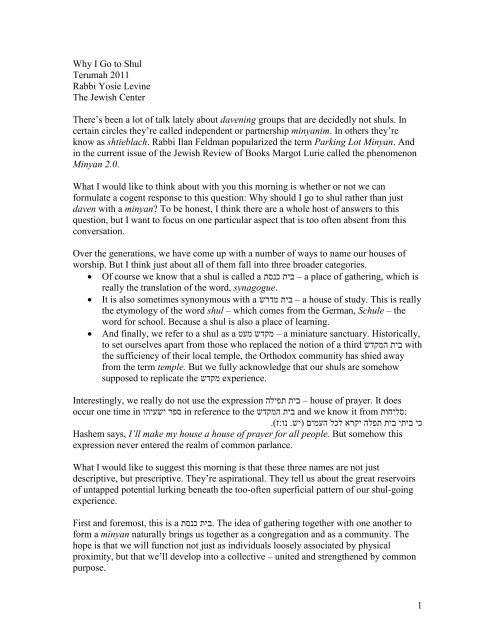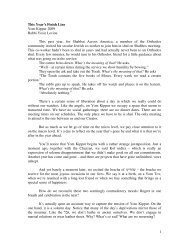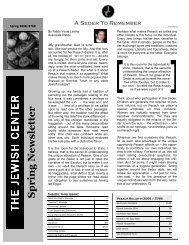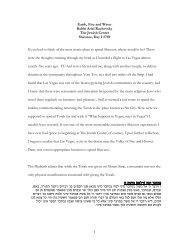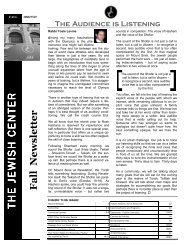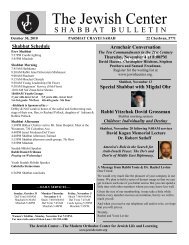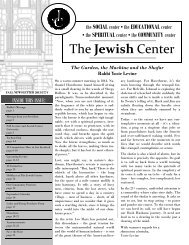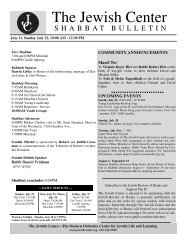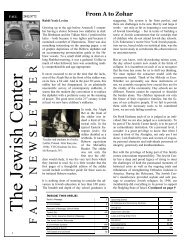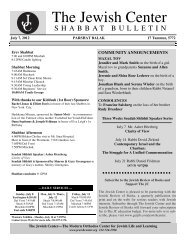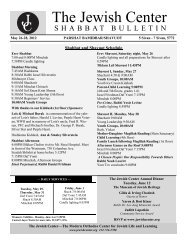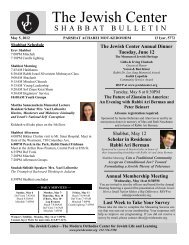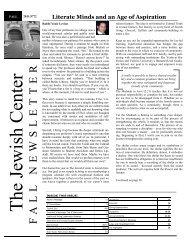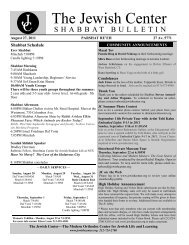Why I Go to Shul Terumah 2011 Rabbi Yosie Levine The Jewish ...
Why I Go to Shul Terumah 2011 Rabbi Yosie Levine The Jewish ...
Why I Go to Shul Terumah 2011 Rabbi Yosie Levine The Jewish ...
Create successful ePaper yourself
Turn your PDF publications into a flip-book with our unique Google optimized e-Paper software.
<strong>Why</strong> I <strong>Go</strong> <strong>to</strong> <strong>Shul</strong><br />
<strong>Terumah</strong> <strong>2011</strong><br />
<strong>Rabbi</strong> <strong>Yosie</strong> <strong>Levine</strong><br />
<strong>The</strong> <strong>Jewish</strong> Center<br />
<strong>The</strong>re’s been a lot of talk lately about davening groups that are decidedly not shuls. In<br />
certain circles they’re called independent or partnership minyanim. In others they’re<br />
know as shtieblach. <strong>Rabbi</strong> Ilan Feldman popularized the term Parking Lot Minyan. And<br />
in the current issue of the <strong>Jewish</strong> Review of Books Margot Lurie called the phenomenon<br />
Minyan 2.0.<br />
What I would like <strong>to</strong> think about with you this morning is whether or not we can<br />
formulate a cogent response <strong>to</strong> this question: <strong>Why</strong> should I go <strong>to</strong> shul rather than just<br />
daven with a minyan? To be honest, I think there are a whole host of answers <strong>to</strong> this<br />
question, but I want <strong>to</strong> focus on one particular aspect that is <strong>to</strong>o often absent from this<br />
conversation.<br />
Over the generations, we have come up with a number of ways <strong>to</strong> name our houses of<br />
worship. But I think just about all of them fall in<strong>to</strong> three broader categories.<br />
• Of course we know that a shul is called a בית כנסת – a place of gathering, which is<br />
really the translation of the word, synagogue.<br />
• It is also sometimes synonymous with a בית מדרש – a house of study. This is really<br />
the etymology of the word shul – which comes from the German, Schule – the<br />
word for school. Because a shul is also a place of learning.<br />
• And finally, we refer <strong>to</strong> a shul as a מקדש מע ט – a miniature sanctuary. His<strong>to</strong>rically,<br />
<strong>to</strong> set ourselves apart from those who replaced the notion of a third בית המקדש with<br />
the sufficiency of their local temple, the Orthodox community has shied away<br />
from the term temple. But we fully acknowledge that our shuls are somehow<br />
supposed <strong>to</strong> replicate the מקדש experience.<br />
Interestingly, we really do not use the expression בית תפילה – house of prayer. It does<br />
:סליחות and we know it from בית המקדש in reference <strong>to</strong> the ספר ישעיהו occur one time in<br />
כי ביתי בית תפלה יקרא לכל העמים (יש. נו:ז).<br />
Hashem says, I’ll make my house a house of prayer for all people. But somehow this<br />
expression never entered the realm of common parlance.<br />
What I would like <strong>to</strong> suggest this morning is that these three names are not just<br />
descriptive, but prescriptive. <strong>The</strong>y’re aspirational. <strong>The</strong>y tell us about the great reservoirs<br />
of untapped potential lurking beneath the <strong>to</strong>o-often superficial pattern of our shul-going<br />
experience.<br />
First and foremost, this is a כנסת .בית <strong>The</strong> idea of gathering <strong>to</strong>gether with one another <strong>to</strong><br />
form a minyan naturally brings us <strong>to</strong>gether as a congregation and as a community. <strong>The</strong><br />
hope is that we will function not just as individuals loosely associated by physical<br />
proximity, but that we’ll develop in<strong>to</strong> a collective – united and strengthened by common<br />
purpose.<br />
1
Davening <strong>to</strong>gether also affords us the opportunity <strong>to</strong> learn; in the process of reading,<br />
speaking and singing our ,תפילות the hope is that our sacred texts will teach us something<br />
about Hashem and about ourselves. And over the generations, we have carved out spaces<br />
within the תפילה for a שיעור or a sermon – תפילה creates a בית מדרש – a place of study.<br />
And finally, our hope is that through תפילה we can create a מעט .מקדש <strong>The</strong> problem is that<br />
– פרשה this term is a little obscure – a little abstract. To understand what it means, our<br />
which describes the original concept of מקדש – is most instructive.<br />
What is the goal of the ?משכן <strong>Why</strong> is it so important for the <strong>Jewish</strong> people <strong>to</strong> build a<br />
tabernacle in the wilderness?<br />
<strong>The</strong> Ramban (Ex. 25:1) argues that the משכן is the means by which <strong>to</strong> perpetuate the<br />
experience of revelation and make it a portable one. It is a way for the <strong>Jewish</strong> people <strong>to</strong><br />
take הר סיני with them on their journey. Notice how many components of that<br />
:משכן extraordinary moment are replicated in the<br />
• <strong>The</strong> fire of the מזבח (Lev. 6:6) symbolizes the fire that descended on Mount Sinai<br />
(Ex. 24:17).<br />
• <strong>The</strong> cloud of smoke created by the incense (30:1-10) corresponds <strong>to</strong> the cloud of<br />
smoke that enveloped the mountain at revelation (19:9, 24:15-18).<br />
• <strong>The</strong> לוחות which Moshe receive at סיני – the tangible testament <strong>to</strong> מתן תורה – are<br />
.משכן and become the enduring centerpiece of the ארון housed in the<br />
• And of course, just as Hashem spoke <strong>to</strong> the people through Moshe from a<strong>to</strong>p the<br />
mountain, so does he continue <strong>to</strong> communicate with Moshe מעל הכפורת – from<br />
a<strong>to</strong>p the cherubs – the highest and holiest place in the tabernacle.<br />
What I would add <strong>to</strong> this is that as much as the משכן appears <strong>to</strong> be an extension of<br />
revelation, it is really quite the opposite. <strong>The</strong> משכן is actually an inversion of סיני .הר It<br />
contains all the same elements as the Sinai experience, but with one fundamental<br />
difference:<br />
At Sinai, for better or worse, the <strong>Jewish</strong> people are a singular, monochromatic entity.<br />
Rembember the famous Rashi? <strong>The</strong> Torah tells us the people camped at the foot of the<br />
.ויחן שם ישראל נגד ההר :(19:2 (Ex. mountain<br />
And Rashi writes (Ex. 19:2):<br />
– the people were as one – with one heart.<br />
<strong>The</strong> ,משכן quite conversely, encourages individualism – not one heart, but many (Ex.<br />
Who contributes <strong>to</strong> the Mishkan? Every .ויקחו לי תרומה מאת כל איש אשר ידבנו לבו :(25:2<br />
individual whose heart so moves him.<br />
כאיש אחד בלב אחד<br />
At Sinai the individual has no voice. We are passive listeners. And in fact, even that<br />
passive listening is <strong>to</strong>o much for us (Ex. 20:16):<br />
ויאמרו אל משה דבר אתה עמנו ונשמעה ואל ידבר עמנו אלהים פן נמות:<br />
Moshe – you speak. <strong>The</strong> burden of listening <strong>to</strong> Hashem directly is <strong>to</strong>o heavy.<br />
2
<strong>The</strong> משכן asks each of us <strong>to</strong> be an active participant and an active parnter. Whatever your<br />
talent, we’ll put it <strong>to</strong> use.<br />
<strong>The</strong> opening of פרשת תרומה is such a stunning aesthetic experience. Imagine in your<br />
mind’s eye all the colors and shapes and textures and smells: gold, silver, turquoise,<br />
scarlet, wool, linen, wood, s<strong>to</strong>ne, oil, spices. It captures the widest possible array of<br />
human contribution.<br />
Building the משכן doesn’t just re-create the Sinai experience. It reframes it in such a way<br />
as <strong>to</strong> include and encourage the active participation of every unique individual.<br />
And that, I would submit <strong>to</strong> you, is what we mean – is what we hope for – when we call<br />
our shul a מעט .מקדש <strong>The</strong> goal is not just <strong>to</strong> build a sanctuary that is aesthetically stunning<br />
like the ;משכן it’s <strong>to</strong> create a community woven <strong>to</strong>gether from the most colorful and<br />
variegated spools of thought and life experience.<br />
While start-ups and shtiebls speak <strong>to</strong> the s’משכן ethic of activism, I actually think what<br />
we are doing at a shul like <strong>The</strong> <strong>Jewish</strong> Center is much more ambitious. Because we aspire<br />
<strong>to</strong> bring <strong>to</strong>gether not only the like-minded and the like-hearted, but an infinitely broader<br />
swath of our extraordinary community. Of course I readily acknowledge that we live in a<br />
denominational world and affiliation limits us by definition. But look around this room.<br />
We are decidedly not monolithic. Our members and young and old; politically and<br />
religiously liberal and conservative; veterans and beginners; they come from a dozen<br />
different countries and find themselves at every age and stage of life.<br />
And because of our size and our depth, our capacity <strong>to</strong> create opportunities for individual<br />
expression – and our capacity <strong>to</strong> create קדושה – is limited only by the confines of our<br />
imagination.<br />
How fabulous that we have come <strong>to</strong>gether this morning <strong>to</strong> participate in a Shabbat of<br />
Song. What a perfect metaphor for this very message. Find your octave; sing your<br />
harmony. Everyone is invited <strong>to</strong> add his or her own contribution.<br />
<strong>The</strong> building of the משכן is a call <strong>to</strong> action. Allow this Shabbos <strong>to</strong> serve as no less. Each<br />
and every person sitting in this room is a wellspring of talent. Yet most of us rarely have<br />
the chance <strong>to</strong> express those gifts and channel them <strong>to</strong>ward a greater good. We are not just<br />
a minyan, but a Center for <strong>Jewish</strong> Life and Learning: From basketball and skiing <strong>to</strong><br />
Talmud and Tanach; from cooking and baking <strong>to</strong> politics and his<strong>to</strong>ry – it’s all here.<br />
<strong>The</strong> opportunities <strong>to</strong> get involved at <strong>The</strong> <strong>Jewish</strong> Center aren’t just portals of entry –<br />
they’re portals <strong>to</strong> a world of קדושה and meaning.<br />
Being a מקדש מעט is an end un<strong>to</strong> itself, but it also strengthens a shul’s other two<br />
components. Our diversity and our capacity for creativity deepen our sense of community<br />
by opening up that many more avenues in which <strong>to</strong> connect with one another. And the<br />
learning environment that generates the most excitement and the most depth emerges not<br />
3
from single-mindedness, but from the collision of competing and conflicting beliefs<br />
exchanged and shared with dignity.<br />
ועשו לי מקדש ושכנתי בתכום (שמות כה:ב).<br />
As the צדה לדרך famously notes, the פסוק doesn’t say: Make for me a sanctuary and I will<br />
dwell within it. But rather – Make for me a sanctuary and I will dwell בתוכם – within you.<br />
<strong>The</strong> edifice doesn’t bring קדושה in<strong>to</strong> this world. We do.<br />
<strong>The</strong> language we have chosen has helped us articulate all that we aspire for a shul <strong>to</strong> be: a<br />
community, a place of learning and a sacred space for every one of us <strong>to</strong> shine. All that<br />
stands between aspiration and actuality is נדיבת לב – the heart <strong>to</strong> make it so.<br />
4


